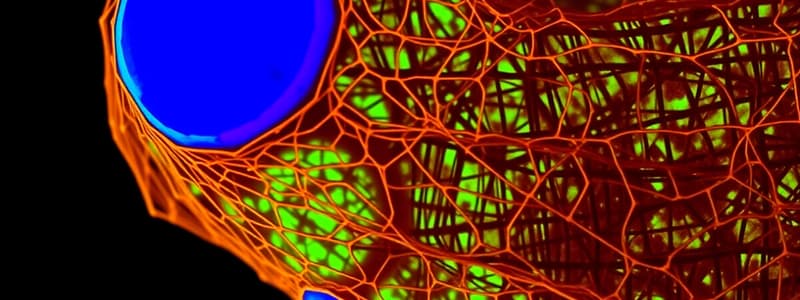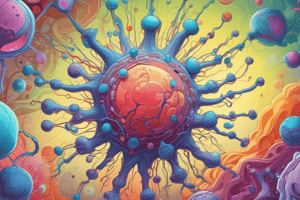Podcast
Questions and Answers
What is the primary role of the nuclear lamina within the nucleus?
What is the primary role of the nuclear lamina within the nucleus?
- Regulating the transport of molecules in and out of the nucleus.
- Modifying and packaging DNA.
- Providing structural support to the nucleus. (correct)
- Synthesizing ribosomal subunits.
Mutation of which protein causes Emery-Dreifuss muscular dystrophy?
Mutation of which protein causes Emery-Dreifuss muscular dystrophy?
- Filamin
- Emerin (correct)
- Lamin A/C
- Actin
What is the key characteristic of FG (phenylalanine-glycine) domains within the nuclear pore complex (NPC)?
What is the key characteristic of FG (phenylalanine-glycine) domains within the nuclear pore complex (NPC)?
- They actively bind and transport specific proteins into the nucleus.
- They form a hydrophobic sieve that restricts diffusion of large macromolecules. (correct)
- They form a hydrophilic sieve to allow diffusion of all molecules.
- They facilitate the active transport of small molecules.
What is required for activation of GTP-binding proteins during nuclear transport?
What is required for activation of GTP-binding proteins during nuclear transport?
Which of the following best describes the role of importins in nuclear transport?
Which of the following best describes the role of importins in nuclear transport?
How are importin α and importin β subunits recycled after protein import?
How are importin α and importin β subunits recycled after protein import?
What structural feature connects the outer nuclear membrane to the endoplasmic reticulum (ER)?
What structural feature connects the outer nuclear membrane to the endoplasmic reticulum (ER)?
What is the functional significance of the continuity between the space between the inner and outer nuclear membranes and the lumen of the rough ER?
What is the functional significance of the continuity between the space between the inner and outer nuclear membranes and the lumen of the rough ER?
What is the key distinction in subunit composition between eukaryotic and prokaryotic ribosomes?
What is the key distinction in subunit composition between eukaryotic and prokaryotic ribosomes?
What best describes the hypothesized origin of the nucleus in eukaryotic cells?
What best describes the hypothesized origin of the nucleus in eukaryotic cells?
What is the primary function of the nucleolus within the nucleus?
What is the primary function of the nucleolus within the nucleus?
What cellular process does ribosome assembly in the nucleolus ensure?
What cellular process does ribosome assembly in the nucleolus ensure?
What is the key function of chromatin in the cell?
What is the key function of chromatin in the cell?
Why do histones facilitate binding to DNA?
Why do histones facilitate binding to DNA?
In the context of nucleosome structure, what is the role of histone H1?
In the context of nucleosome structure, what is the role of histone H1?
What role do histone interactions play in the formation of higher-ordered chromatin structures, such as the 30 nm fiber?
What role do histone interactions play in the formation of higher-ordered chromatin structures, such as the 30 nm fiber?
What protein stabilizes the supercoiled loops of the 30 nm chromatin fibers, organizing them into even higher-order structures?
What protein stabilizes the supercoiled loops of the 30 nm chromatin fibers, organizing them into even higher-order structures?
Considering the levels of chromatin organization, what compaction ratio is achieved in mitotic chromosomes?
Considering the levels of chromatin organization, what compaction ratio is achieved in mitotic chromosomes?
What is the primary utility of a karyotype?
What is the primary utility of a karyotype?
How does the behavior of euchromatin differ from that of heterochromatin after mitosis?
How does the behavior of euchromatin differ from that of heterochromatin after mitosis?
What distinguishes constitutive heterochromatin from facultative heterochromatin?
What distinguishes constitutive heterochromatin from facultative heterochromatin?
Which of the following components is transported through the nuclear pore complexes (NPCs) via passive diffusion?
Which of the following components is transported through the nuclear pore complexes (NPCs) via passive diffusion?
To what part of the nucleus are these ribosomal proteins delivered and assembled on pre-rRNA to make pre-ribosomal RNA?
To what part of the nucleus are these ribosomal proteins delivered and assembled on pre-rRNA to make pre-ribosomal RNA?
What protein regulates the integrity of nuclear lamina?
What protein regulates the integrity of nuclear lamina?
Flashcards
Nuclear Envelope
Nuclear Envelope
The double membrane structure surrounding the nucleus in eukaryotic cells, consisting of inner and outer membranes, nuclear lamina, and nuclear pore complexes.
Perinuclear Space
Perinuclear Space
The space between the inner and outer nuclear membranes.
Nuclear Lamina
Nuclear Lamina
A fibrous network that provides structural support to the nucleus.
Nuclear Pore Complexes (NPCs)
Nuclear Pore Complexes (NPCs)
Signup and view all the flashcards
Outer Nuclear Membrane
Outer Nuclear Membrane
Signup and view all the flashcards
Inner Nuclear Membrane
Inner Nuclear Membrane
Signup and view all the flashcards
Chromatin
Chromatin
Signup and view all the flashcards
Nuclear lamina functions
Nuclear lamina functions
Signup and view all the flashcards
Lamin A/C Mutation
Lamin A/C Mutation
Signup and view all the flashcards
Lamin B Mutation
Lamin B Mutation
Signup and view all the flashcards
Passive Diffusion (NPC)
Passive Diffusion (NPC)
Signup and view all the flashcards
Energy-Dependent Transport
Energy-Dependent Transport
Signup and view all the flashcards
DNA-binding proteins
DNA-binding proteins
Signup and view all the flashcards
Shuttling nuclear transport receptors (importins)
Shuttling nuclear transport receptors (importins)
Signup and view all the flashcards
Nuclear Pore Complex (NPC)
Nuclear Pore Complex (NPC)
Signup and view all the flashcards
Ran-GTP Activation
Ran-GTP Activation
Signup and view all the flashcards
Ran-GTP Inactivation
Ran-GTP Inactivation
Signup and view all the flashcards
Nuclear Localization Signal (NLS)
Nuclear Localization Signal (NLS)
Signup and view all the flashcards
Importin α/β heterodimer
Importin α/β heterodimer
Signup and view all the flashcards
Nucleolus
Nucleolus
Signup and view all the flashcards
40S and 60S Ribosomal Subunits
40S and 60S Ribosomal Subunits
Signup and view all the flashcards
Chromatin
Chromatin
Signup and view all the flashcards
Histones
Histones
Signup and view all the flashcards
Nucleosome
Nucleosome
Signup and view all the flashcards
Constitutive Heterochromatin
Constitutive Heterochromatin
Signup and view all the flashcards
Study Notes
Nuclear Envelope Structure
- Consists of two concentric membranes, which are the inner and outer nuclear membranes.
- Includes the nuclear lamina, a fibrous network that provides structural support to the nucleus.
- Contains nuclear pore complexes, the only channels allowing molecules to travel between the nucleus and the cytoplasm.
Nuclear Lamina
- Supports the nuclear envelope, which is composed of lamins.
- The integrity of the nuclear lamina is regulated by phosphorylation/dephosphorylation.
- Lamin A/C mutation causes Hutchinson-Gilford Progeria syndrome.
- Lamin B mutation causes leukodystrophy (loss of myelin).
- Mutations in lamin binding protein emerin cause Emery-Dreifuss muscular dystrophy, characterized by stiff elbows, neck, heels, and heart problems.
Traffic Through Nuclear Pore Complexes (NPCs)
- Molecules can move through NPCs via passive diffusion or energy-dependent transport.
- Passive diffusion is used by small molecules.
- Energy-dependent transport is involves proteins and RNAs.
- DNA-binding proteins, histones, nonhistone proteins, activators and repressors of transcription, messenger RNA (mRNA)-binding proteins, components of the nucleus like lamins, ribosomal proteins, and shuttling nuclear transport receptors (importins) are transported via energy-dependent transport.
- mRNAs (together with mRNA-binding proteins), tRNAs (transfer RNAs), and 40S and 60S ribosomal subunits (complexes of ribosomal RNAs [rRNAs] and ribosomal proteins) move through NPCs.
Nuclear Pore Complex (NPC) Structure and Function
- NPCs are huge complexes, 15-30 times the mass of a ribosome, exhibiting octagonal symmetry.
- The channel of an NPC is 20-30 nm wide.
- FG (phenylalanine-glycine) domains form a hydrophobic sieve that blocks the diffusion of larger macromolecules, specifically those greater than approximately 40,000 Daltons.
- The model of a vertebrate nuclear pore complex (NPC) consists of a scaffold that anchors the complex to the nuclear envelope, a cytoplasmic and a nuclear ring, a nuclear basket, and eight cytoplasmic filaments.
Import of Proteins Through the NPC
- Proteins synthesized in the cytoplasm are targeted to the nucleus by a nuclear localization signal (NLS), such as P-K-K-K-R-K-V, which has basic residues.
- Proteins with an NLS bind to an NLS receptor, specifically importin α/β heterodimer.
- The protein/importin complex associates with cytoplasmic filaments.
- The protein/importin complex passes through the NPC.
- The complex associates with a GTPase called Ran.
- The Ran.GTP-importin β complex is transported back to the cytoplasm, where Ran is converted to Ran.GDP and brought back into the nucleus; importin α is returned to the cytoplasm via a protein named exportin.
GTP Binding and Hydrolysis
- GTP binding (activation) requires a protein called GEF (guanine nucleotide exchange factor).
- Hydrolysis of GTP to GDP (inactivation) requires a GAP (GTPase activating protein).
Nuclear Membrane Continuity
- The outer nuclear membrane is continuous with the rough endoplasmic reticulum (ER).
- The space between the inner and outer nuclear membranes is continuous with the lumen of the rough ER.
Ribosome Structure
- Eukaryotic (vertebrate) ribosomes have 28S, 5.8S, and 5S rRNA subunits totaling 50 proteins, and 18S rRNA subunits totaling 33 proteins.
- These subunits assemble into 80S ribosomes.
- Prokaryotic ribosomes have 23S and 5S rRNA subunits totaling 31 proteins, and 16S rRNA subunits totaling 21 proteins.
- These subunits combine into 70S ribosomes.
Early Origins of the Nucleus
- An ancient prokaryotic cell, containing DNA and membrane-bound ribosomes, evolves to contain a endoplasmic reticulum, inner and outer nuclear membrane, a nuclear pore, a nucleus and the cytsosol to become an ancient eukaryotic cell.
Nucleolus
- The nucleolus is a suborganelle of the nucleus.
- It functions as a site where ribosomes are assembled.
Ribosome Assembly in the Nucleolus
- Ribosomal proteins are imported to the nucleus from the cytoplasm and then delivered to the nucleolus.
- These proteins assemble on pre-rRNA (pre-ribosomal RNA).
- The pre-rRNA is cleaved to form several rRNAs.
- Ribosomal proteins and rRNAs assemble to form the 40S and 60S ribosomal subunits.
- These subunits are exported to the cytoplasm because the fully assembled ribosome is too large to fit through the pore, ensuring protein synthesis takes place in cytoplasm.
Chromatin Structure
- Chromosomal DNA is packed into chromatin fibers with the aid of specialized proteins.
- Complexes of eukaryotic DNA and proteins are called chromatin.
- Chromatin contains about twice as much protein as DNA.
- The major proteins of chromatin are histones.
- Histones are small proteins (11 to 23 kDa) containing a high proportion of basic amino acids (arginine and lysine), facilitating binding to the negatively charged DNA molecule.
- The 5 major types of histones are H1, H2A, H2B, H3, and H4, which are very similar among different species of eukaryotes.
- Chromatin also contains an approximately equal mass of nonhistone chromosomal proteins, with more than 1000 different types.
Chromatin Organization
- DNA is wrapped around an octamer of histones H2A, H2B, H3, and H4 in a nucleosome core particle and sealed by histone H1.
- This produces a 7-fold compaction of the DNA.
- Non-histone proteins bind to the linker DNA between nucleosome core particles.
- Formation of 30 nm fibers is dependent upon histone interactions and further increases compaction by approximately 6-fold.
- The 30 nm fibers are then organized into 80-100 nm supercoiled loops, possibly stabilized by a protein called cohesin.
- Mitotic chromosomes represent the ultimate in chromatin compactness, with a ratio of 10,000:1 (1 μm of mitotic chromosome length contains approximately 1 cm of non-compacted DNA).
- Chromatin condenses into chromosomes that can be distinguished in the light microscope as a cell prepares to divide into two daughter cells.
- The chromosomes can be arranged in a karyotype, a preparation of homologous pairs ordered according to size, and may be used to screen chromosomal abnormalities.
Heterochromatin vs Euchromatin
- Euchromatin returns to a dispersed state after mitosis.
- Heterochromatin is condensed during interphase.
- Constitutive heterochromatin remains condensed all the time and is found mostly around centromeres and telomeres; it consists of highly repeated sequences and few genes.
- Facultative heterochromatin is inactivated during certain phases of an organism's life, such as X-inactivation.
Studying That Suits You
Use AI to generate personalized quizzes and flashcards to suit your learning preferences.



